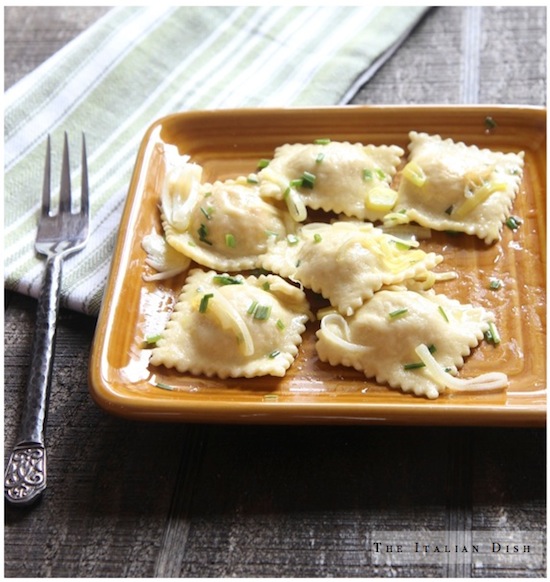
I have some upcoming pasta classes in the next few weeks and it's always fun to demonstrate to students how easy it is to make homemade ravioli. There's so many ways to make ravioli, but my favorite way is to use this mold. I can make ravioli so fast with this thing. All you have to do is to roll out the pasta sheets, press into your mold, place a little filling in each well and lay another sheet on top. Flip the mold over, cut and separate the ravioli. It's fun. The mold enables you to make nice uniform ravioli, which will cook up evenly.
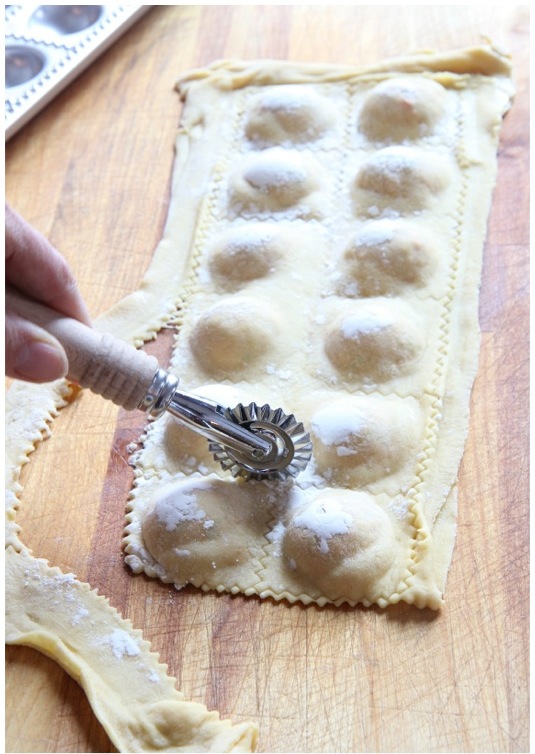
I've been making these salmon ravioli for years. Sometimes I change the recipe slightly, using shallots instead of leeks or different herbs but the basic recipe stays the same. It's so easy to make the filling - just lightly cook cubed salmon with a little bit of onion and white wine and some seasoning. Add some cheese and a little egg for a binder and process in your food processor. It just takes a few minutes.
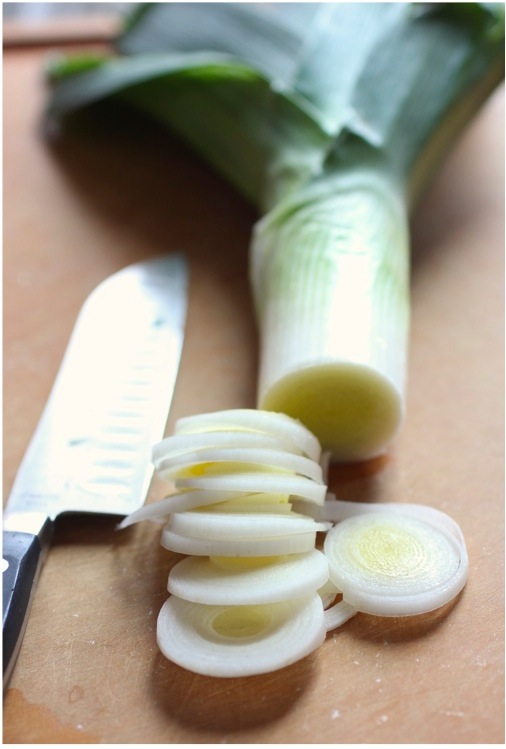
Salmon Ravioli
for a printable recipe click here
makes about 40 ravioli, if using the mold
The sauce below is for about 20 ravioli. I usually freeze the other 20 ravioli for another meal. If you want to cook and serve all 40 ravioli, just double the sauce recipe.
Ingredients:
for the pasta:
- 3 eggs, room temperature
- 1-3/4 cup flour (more or less)
for the filling:
- 1 tablespoon olive oil
- 1/2 leek, thinly sliced, white part only
- 12 ounces salmon, skin removed and cut into cubes
- 3 tablespoons dry white wine
- 1 tablespoon chopped chives
- 1 tablespoon chopped parsley
- 2 tablespoons grated Parmigiano cheese
- 1 egg
- salt and pepper
- 1 tablespoons lemon zest
for the sauce:
- 1-1/2 leeks, thinly sliced
- 2 tablespoons olive oil
- 2 tablespoons butter
- juice of 1 lemon
- 1 tablespoon chopped chives for garnish
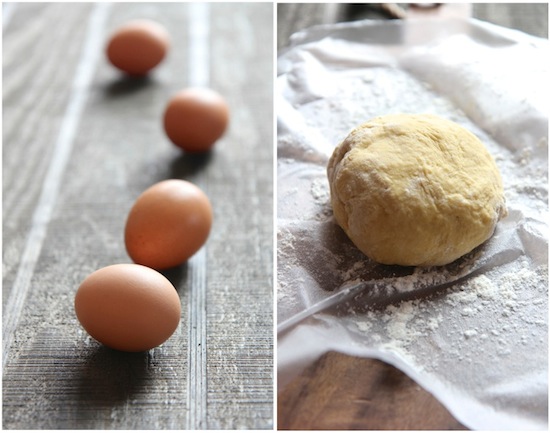
Instructions:
Make the pasta:
Mound the flour on the counter and make a well in the middle. Break the eggs into this well and, with a fork, whisk the eggs until slightly beaten. With the fork, start incorporating the flour a little at a time until a dough forms. If the dough is too sticky, add more flour. Only add enough of the flour to make a dough that is still slightly wet but not sticky enough to come off on your fingers when you press into it. Knead the dough for a couple of minutes and wrap in floured plastic wrap. Let rest on the counter for 20 minutes.
Make the filling:
In a large saute pan, heat the oil and leeks and saute the leeks over medium low heat until soft. Add the salmon and cook gently for about 5 minutes. Add the white wine and cook for a couple of minutes just until the wine has cooked off and the salmon is just barely cooked. Remove and place in the bowl of a food processor. Let cool for several minutes. (You can use this same saute pan to make the sauce for your finished ravioli).
Add the chives, parsley, cheese, lemon zest and egg to the food processor. Add a pinch of salt and some pepper and pulse. Taste for salt and pepper and adjust accordingly. Pulse until mixture is fairly fine. Refrigerate filling until you are ready to assemble the pasta.

Assemble the ravioli:
Cut the pasta dough into two pieces. Keep the dough you are not using wrapped. Make sure your pasta rollers are on the #1 setting, the widest. Flatten your piece of dough and run it through the rollers. Flour it, fold it into thirds, and run it through again. Do this three or four times. Set the rollers to #2 and run your dough through that setting. Do not fold dough this time. Keep running it through the rollers until you get to setting #4 or #5. I usually make my ravioli no thinner than these settings. I find that if the dough is too thin, the ravioli tend to burst when you cook it. If you like thinner dough, use #5. Keep in mind as you are making the pasta sheets, that you want them as wide as possible so that they cover your ravioli mold. (If you are not using a mold, don't worry about that.) It helps to grab the sheets as they are coming out of the rollers and stretch them width-wise a little bit. Take the sheets of pasta and lay them on a floured countertop. If you are not very speedy and are going to take a while to make the remainder of the sheets, cover the pasta sheets with a towel or plastic wrap, so they don't dry out. You want them slightly moist for ravioli, as opposed to dry when making other cut pasta.
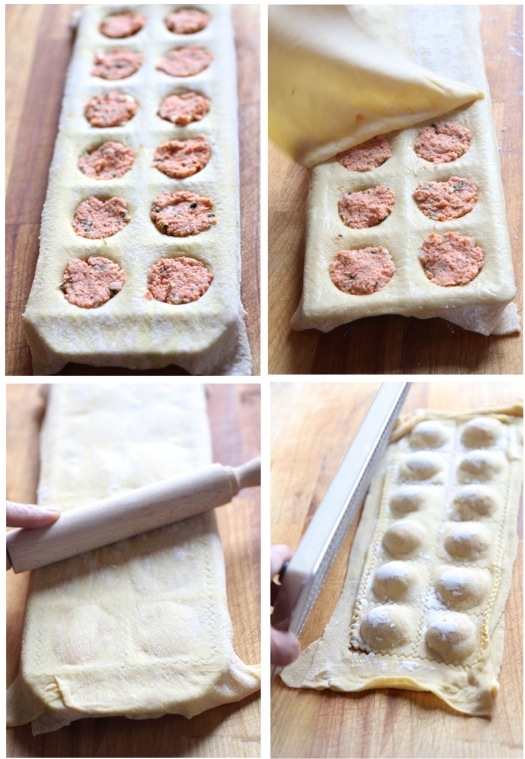
This ravioli mold makes these a breeze
Repeat with remaining dough until you have made all your pasta sheets. If you have a ravioli mold, flour it well. Cut your sheets slightly longer than your ravioli mold. Lay one sheet of pasta on the mold, making sure the entire mold is covered. Take a pastry bag and squeeze out about a tablespoon of filling into each well or you can just use a spoon and spoon filling into the mold. Spritz the pasta sheet with a little water or brush a little water in between all the filling. Lay the second sheet on top and run a rolling pin over to seal. Turn the mold over and release the ravioli. They will not be separated. Use a fluted pastry wheel to cut apart. Lay the ravioli on a floured baking pan and continue making ravioli until you've used all the pasta sheets. Any leftover pasta trimmings can be gathered together and used to make another sheet. You should have enough pasta to make about 40 ravioli.
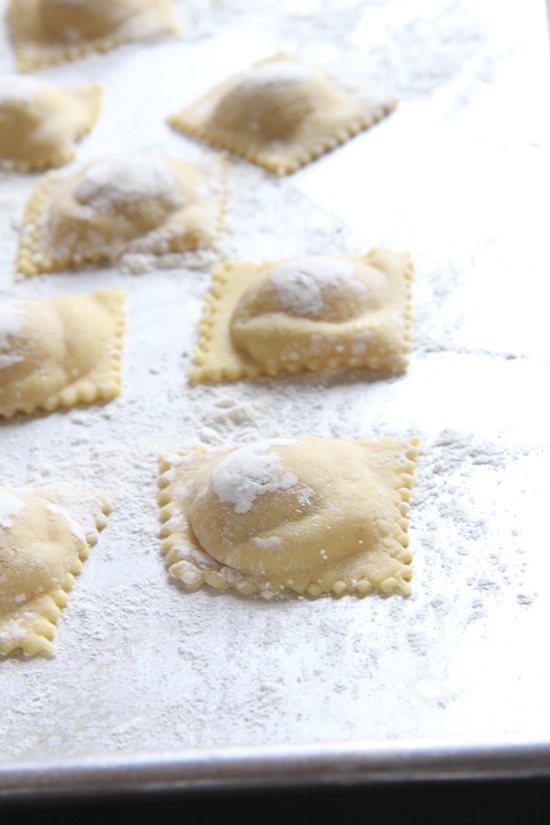
You can store the ravioli on baking sheets in the refrigerator until you are ready to use them. Cover loosely with plastic wrap. You can also freeze them on baking sheets and then stick them in zip locks. To cook after being frozen, do not defrost first.
Bring a large pot of salted water to a boil. Meanwhile, make the sauce.
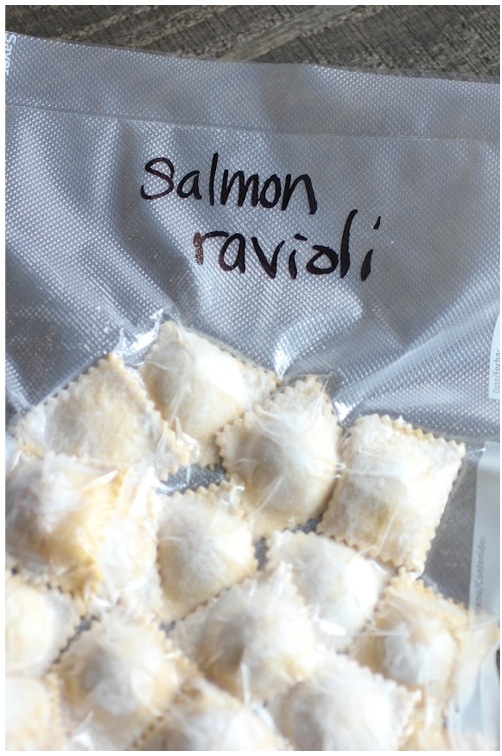
ravioli freezes really well and requires no defrosting when you cook them
Make the sauce:
In a large saute pan, melt the olive oil and butter. Add the leeks and cook until they are soft. Add the lemon juice. Keep this mixture on low until you add your cooked ravioli:
To cook: Add the ravioli to your boiling water about 10 at a time. Bring the water back to a gentle simmer and cook for about 3-4 minutes. (If ravioli is frozen, cook about a minute more). Remove with a slotted spoon or handled strainer to the sauce in your saute pan. Continue cooking the remainder of ravioli. Add to your saute pan and blend gently with sauce. Add salt and pepper to taste and chopped chives for garnish.
